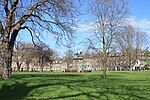The Georgian House, Edinburgh
1796 establishments in ScotlandCategory A listed buildings in EdinburghHistoric house museums in EdinburghHouses completed in 1796Listed houses in Scotland ... and 4 more
National Trust for Scotland propertiesNew Town, EdinburghRobert Adam buildingsUse British English from October 2017

The Georgian House is an 18th-century townhouse situated at No. 7 Charlotte Square in the heart of the historic New Town of the city of Edinburgh, Scotland. It has been restored and furnished by the National Trust for Scotland, and is operated as a popular tourist attraction, with over 40,000 visitors annually.
Excerpt from the Wikipedia article The Georgian House, Edinburgh (License: CC BY-SA 3.0, Authors, Images).The Georgian House, Edinburgh
Charlotte Square, City of Edinburgh New Town
Geographical coordinates (GPS) Address Nearby Places Show on map
Geographical coordinates (GPS)
| Latitude | Longitude |
|---|---|
| N 55.9525 ° | E -3.2080555555556 ° |
Address
Bute House
Charlotte Square 6
EH2 4DR City of Edinburgh, New Town
Scotland, United Kingdom
Open on Google Maps











